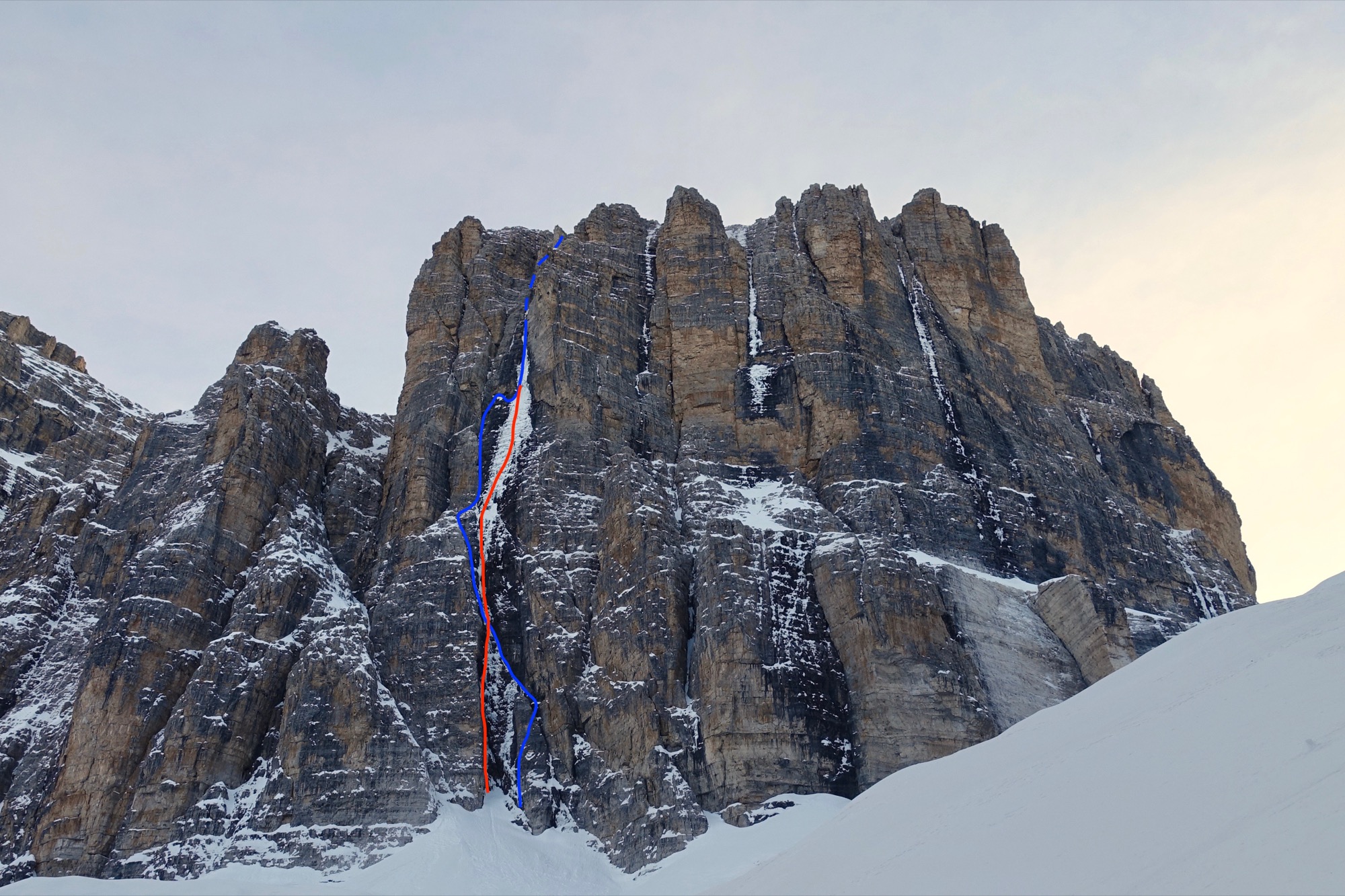Blog
Heart of Stone
We are first month in what might be a journey of our life. Traveling and climbing along the whole “Panamericana” finally started for us and considering a situation we definitely feel privileged to be able to do it. This year we are staying in Alaska for three months and first month already offered us both sides of alpine climbing. In Revelations we got totally shut down because of weather and conditions in the beginning of April. After s short break in Seward luck was on our side in Denali National Park.
After checking the walls along Ruth glacier Paul Roderick dropped us below Huntington west face, as it seemed in most promising conditions, from what we were able to see from the small airplane. After setting a base camp, we quickly went to work in the wall on the route Colton Leach early the following morning. We were relieved to find good conditions and quickly progressed on moderate ice, many times stretching the pitches up to 150m. Being quick payed off as the snow on the ramps in the middle part wast still frozen when we reached it and enabled us to continue in good peace. At the end of the ramps we “zig zaged ” through the rocky section and climbed a short section or really cool step cracks in perfect granite to the snow flank above. On this we found a trail from the party that had climbed the Harward route a couple of days prior. We smoothly followed it to the summit ridge and along it to the top of Mt Huntington. It was really calm and warm at the summit but we quickly started with descent as we didn't bring any bivy gear. We down climbed the ridge and one more rope length from the ridge and then rappelled making V-threads except from a few rock belays that we found. It was a rather straight forward rappelling and once in the west face couloir I kept looking in the steep wall to the climbers left of us. The rock looked very solid but full of good looking cracks. The idea of climbing in this part of the wall seemed very good but at that moment we didn't seriously think of doing it as we were still busy with coming back to our tent in the last light of the day.
The day after we were relaxing in the warm sun and started thinking what to try next after we got a very promising weather forecast for three more days from Jack Tackle who is very kindly sharing his knowledge with us while we are her in Alaska. Warm temperatures seemed perfect for that steep rock wall, we saw on the descent. We even had climbing shoes with us in base camp, because we didn't know, where we will end on this trip. We relatively quickly decided to try it after one more rest day. This time we packed bivy gear more friends and also rock shoes. From what we saw, we thought, we will be rock climbing for few pitches to reach an obvious mixed ramp system. For that same reason we decided to start late from our base camp to use the warmth of afternoon sun for rock climbing.
Cloudless blue sky accompanied us, when we left our camp for the second time at 11am on April 26th. We found perfect conditions on initial snow slope that we shared with the West face couloir route and arrived smoothly to the steep wall, just when the sun hit it. At the place where we started climbing new terrain we spotted a big heart feature on a blank granite face. It felt almost to sweet for us a climbing couple, so we both laughed at the belay. To our surprise the crack system that seemed the most logical was filled with ice. It was kind of a weird ice. It was the same colour as the rock because of all the dirt in it. This is why we couldn't see it from the distance. Rock shoes stayed in the backpack and we continued in full on mixed climbing mode.
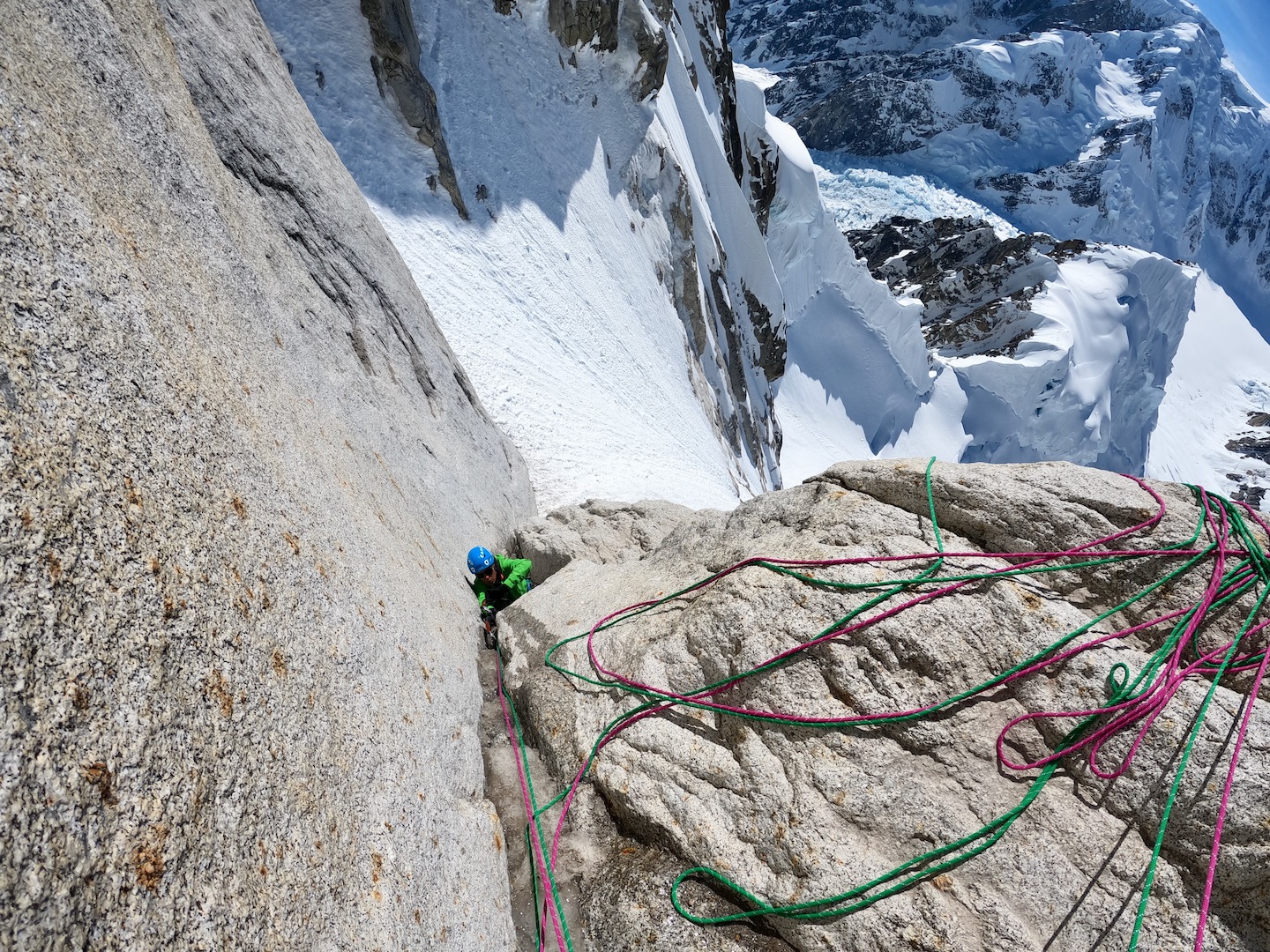
The climbing was steep and almost every pitch had a kind of a boulder problem crux. Some of them quite powerful but luckily with mostly decent protection. At that point there was already water running down the face and ice became really rotten and slushy. It seemed we got the last day in that window before the ice would disappear. In the last pitch before reaching a right trending ramp system we had a first little shock when Ines pulled of a loose hold and just barely managed to catch herself. The ramp itself went very quick for a half rope length and then I got stuck for quite some time on one of those boulder cruxes. I underestimated it and started climbing up it with a backpack. Move for move and lots of cleaning of useless snow and trying to find ok placements in thin ice I found myself in a really awkward position where I couldn’t take of my back pack anymore and hang it into a piece. I started reaching as far as I could towards the first ok looking ice but I couldn’t reach it. I hammered the lower tool as deep as I could into the ice and grabbed it at the head of the tool. With this extra reach I just barely reached the next ice and though I have it when it all broke and fall off. I was off too for a moment and I still don't know how I managed to catch the lower tool in the fall and actually not fall. After a some breathing I tried again and that time it luckily worked out.
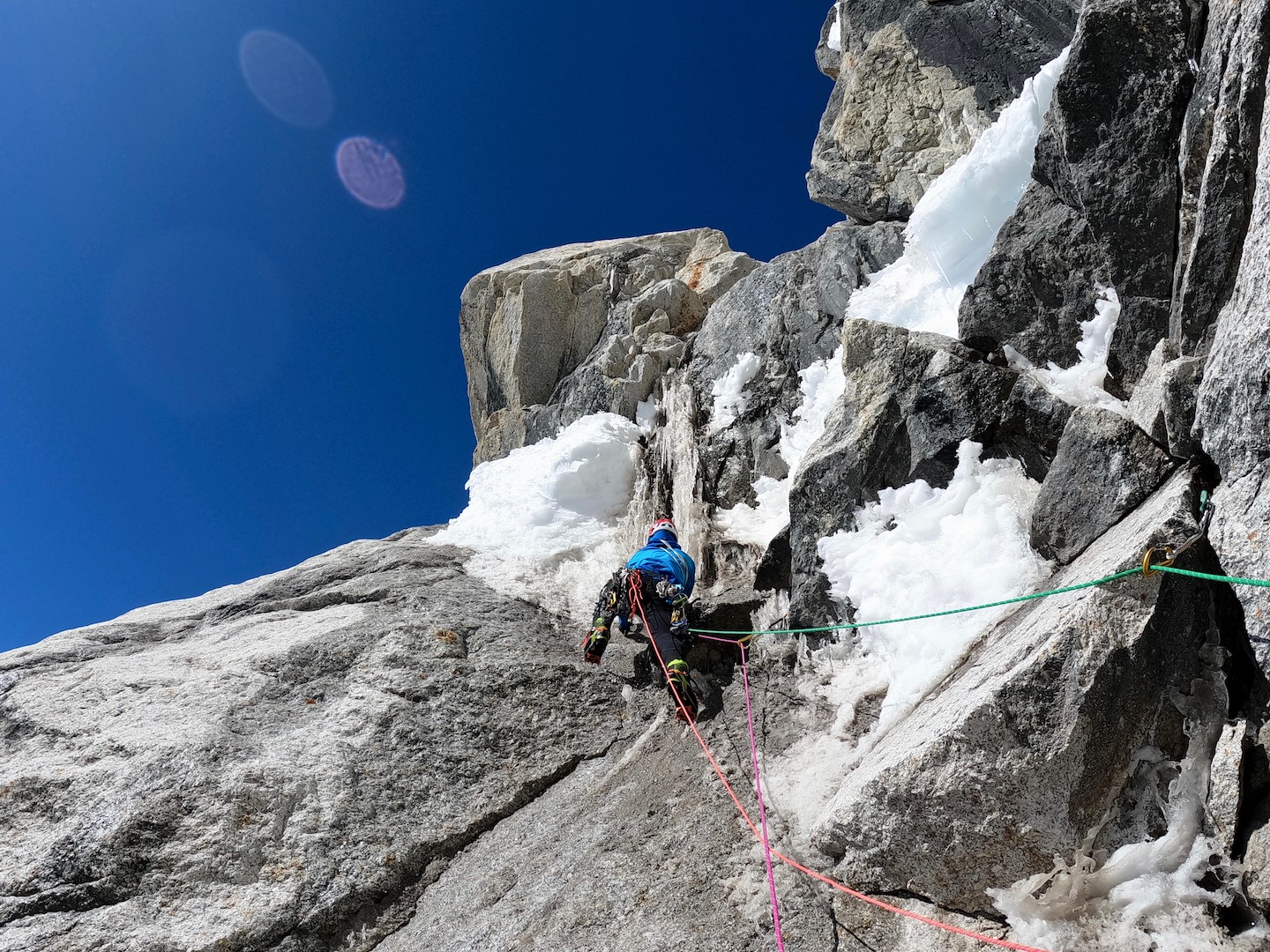
The rest of the ramp went really well with some great ice and good hooking in the cracks until the very last pitch before snow flank. This pitch took almost two hours of digging on the side of a huge mushroom and with quite bad and run out protection. It was definitely the most serious pitch in the route, especially as it was already dark when we climbed it. In two more rope stretches we reached a perfect bivy spot below a big block. It was already 3 in the morning and we felt tired but full moon came out and we couldn’t go to sleep for almost two more hours as it was so nice.
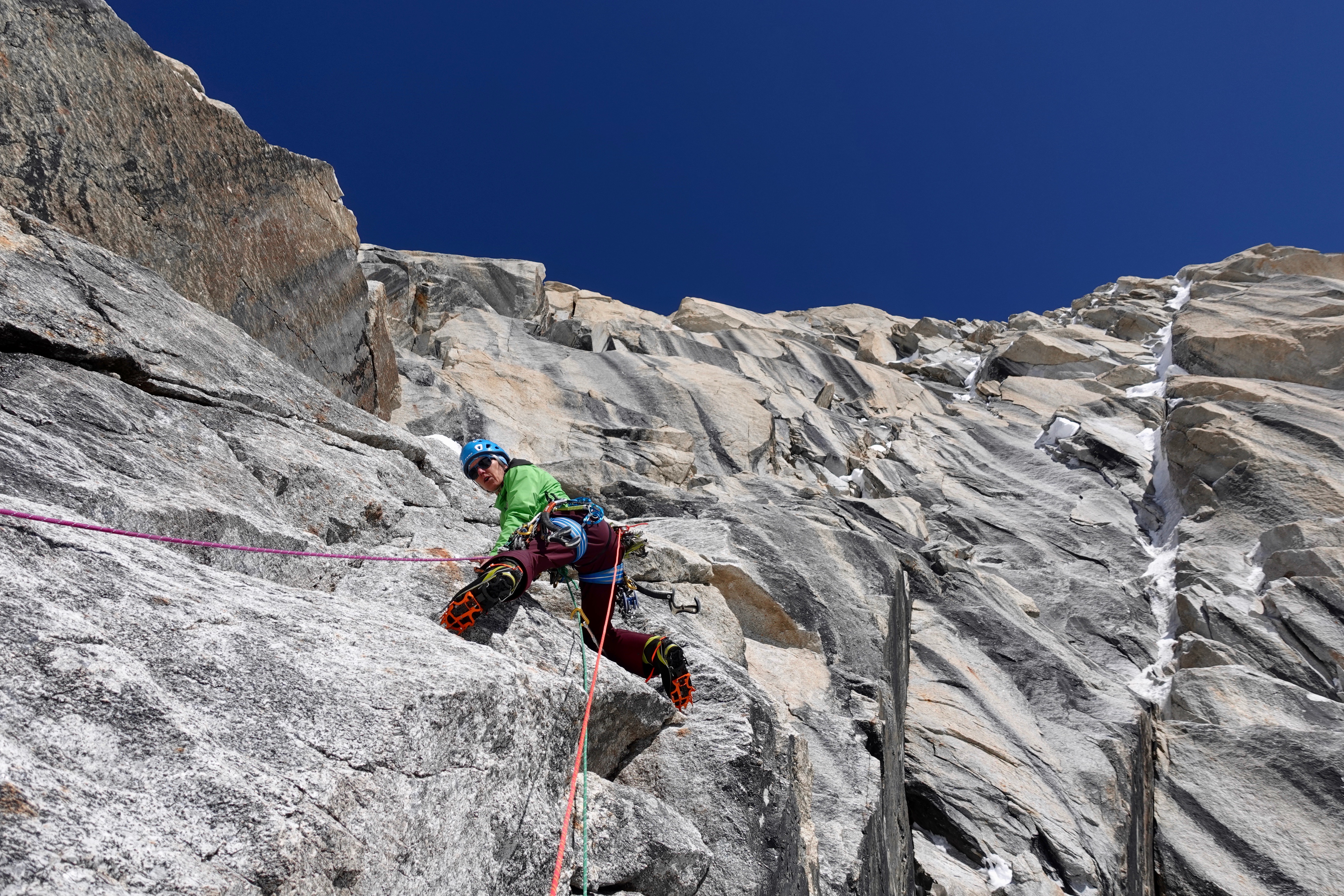
The next morning we left our bivy site with one backpack only and reached the summit of Huntington already at 11am. We were sitting there for almost an hour and couldn't believe how warm it was. In any direction we looked we could only see wild Alaskan mountains and started wondering where all our journey will take us. The descent went really smooth because we knew it already and we reached our base camp in the afternoon for an early dinner. After checking with Jack Tackle and Mark Westman, we figured out that, we climbed a new route. After initial snow slopes we climbed 20 pitches of new terrain before joining other routes on the summit snow flank.
The feature that perfectly marks the start of our route gave the route its name “Heart of Stone”.
We would like to thank Jack Tackle and Mark Westman for their help and knowledge about Alaska they shared with us.

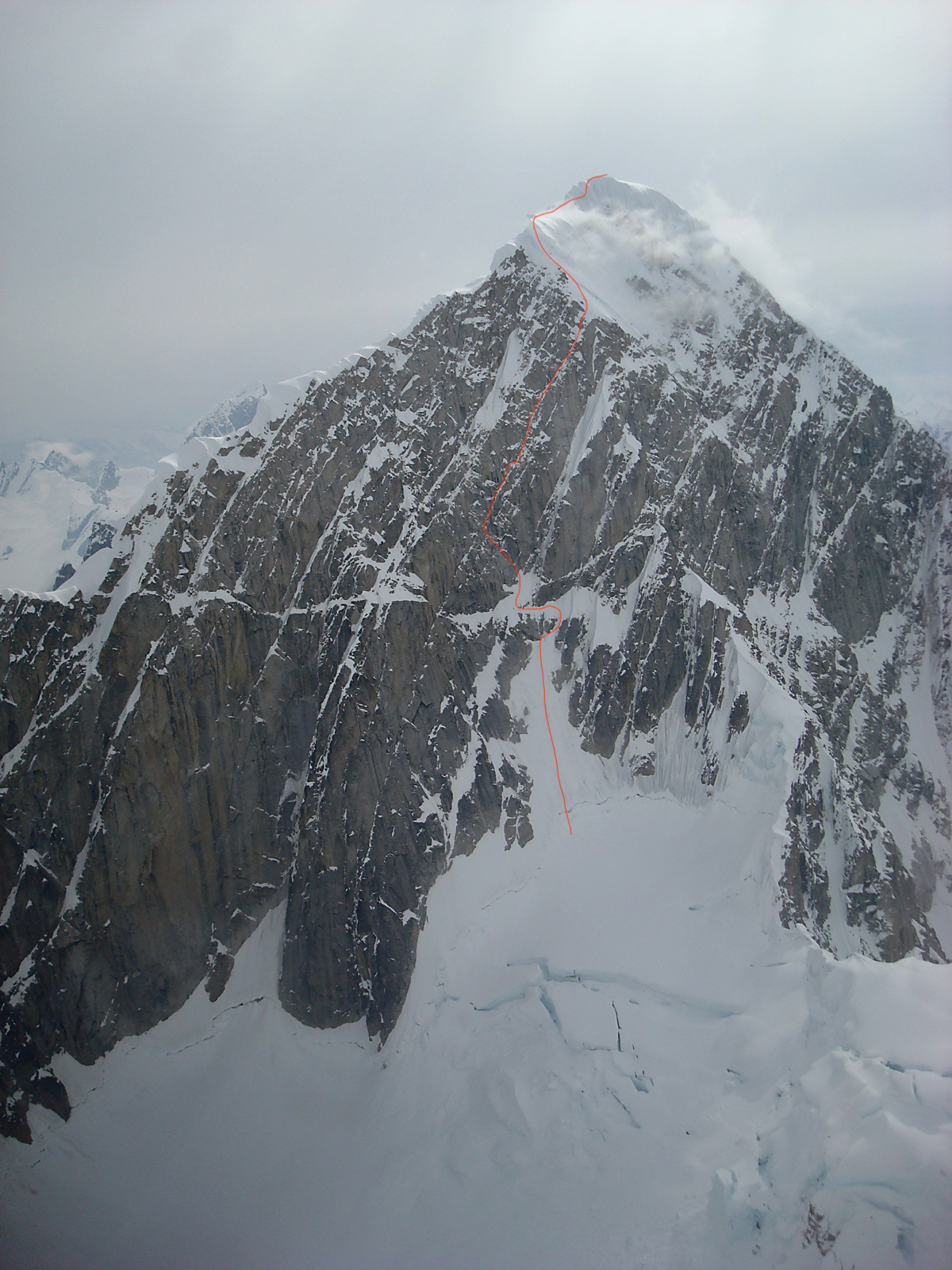
Facts:
Central Denali Range
Mount Huntington, west face
New Route, “Heart of Stone
1050m, M7, 50-90°
FA: 26/27.4.2021
Gear needed:
-6 ice screws
-set of friends 0.2-3 and some double in middle sizes
-set of nuts
-4 pitons
Finding peace in a busy Patagonia
The conditions for our plan A in this season never developed good enough so we started looking for a plan B. Steep, relatively safe and wind sheltered south face of Aguja Saint-Exupery seemed like a smart project and an attempt we found in the guidebook looked promising. We decided to check it out and immediately liked the wall and its quiet ambiance.
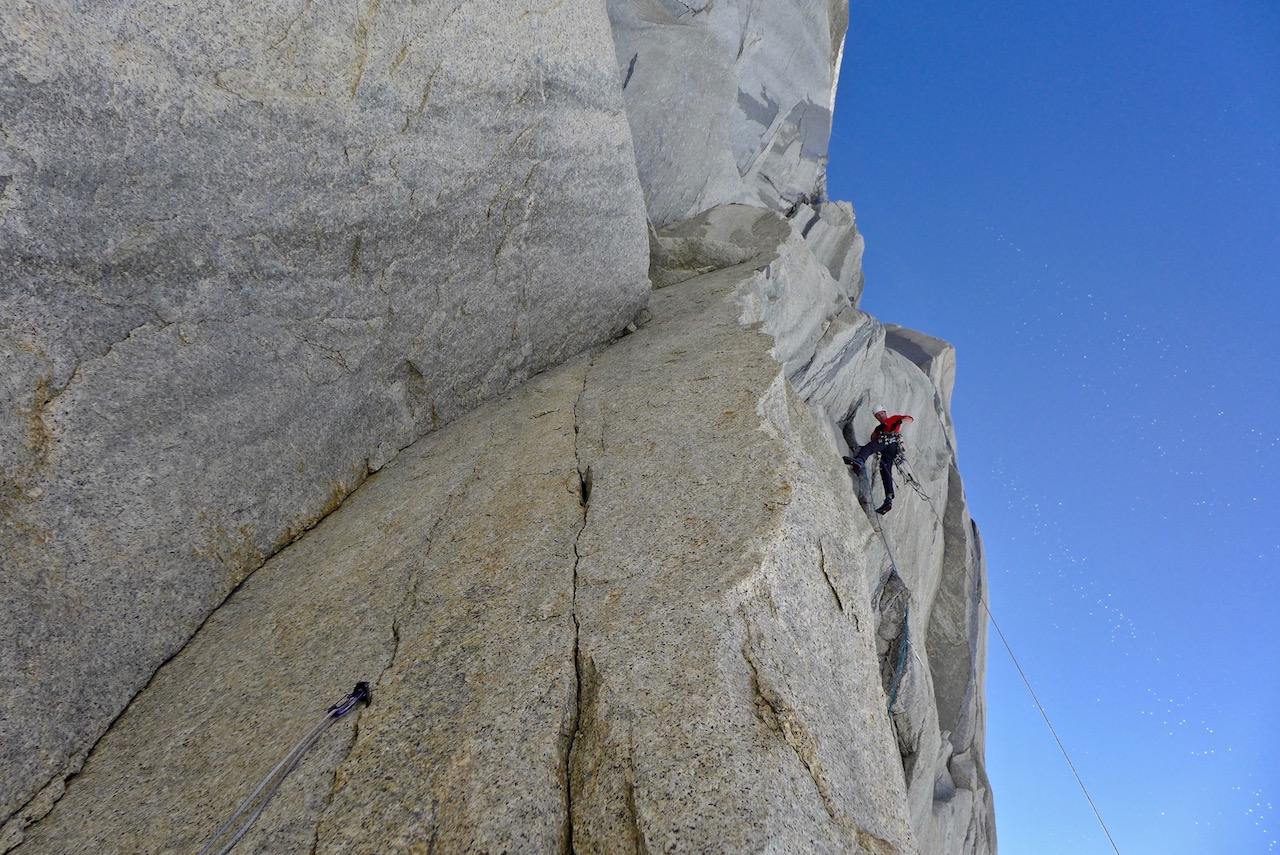
First attempt went well despite relatively cold temperatures and lots of ice in the cracks. We climbed first six pitches and found a few bolts from the first attempt party and then continued for another three to find a perfect bivy spot at the base of an obvious corner. Same day we climbed and fixed two more pitches for a faster start the next day. In the following morning we quickly jummared up our rope and started climbing a long and steep traverse into the big overhangs. The weather was perfect but we reached the point where we didn't want to commit to the terrain above us. We only had a single climbing rope, a 5mm tag line and few pitons left. The line looked possible with some luck with the features but not a guarantee. because of a long overhanging traverse ahead, we decided that the retreat would be too risky if we continue with the gear we had and turned around. We didn't think of trying the route again at that time and carried everything back to town.
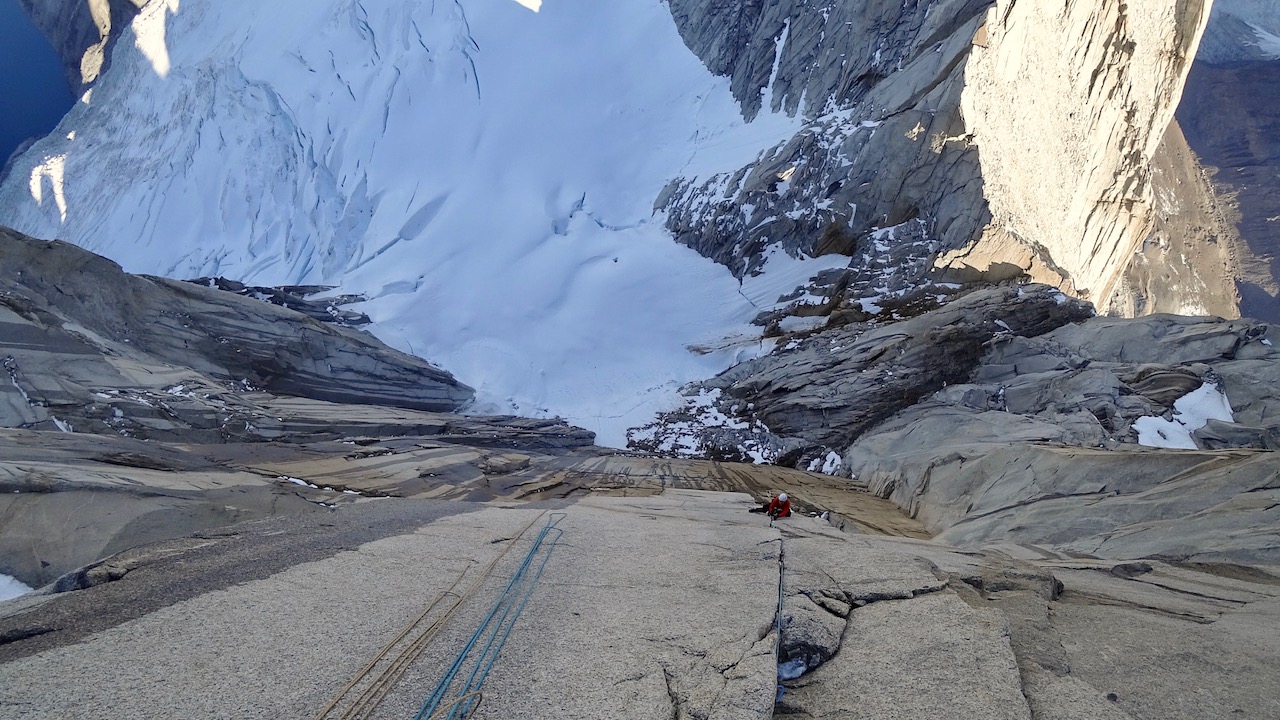
Back in El Chalten the route didn't give us peace in our minds and we started thinking of trying again. we began collecting gear from others as we didn't bring enough with us from home. Rolando Garibotti and Thomas Huber generously borrowed us all that we missed and we were ready for the second round. Bringing more gear was the only change in tactics. This included one extra rope to fix in the overhanging traverse dihedral until we would see if we can get through. In case it would not work out, we could descent easier using the fixed rope to pull us to the wall in the overhanging terrain.
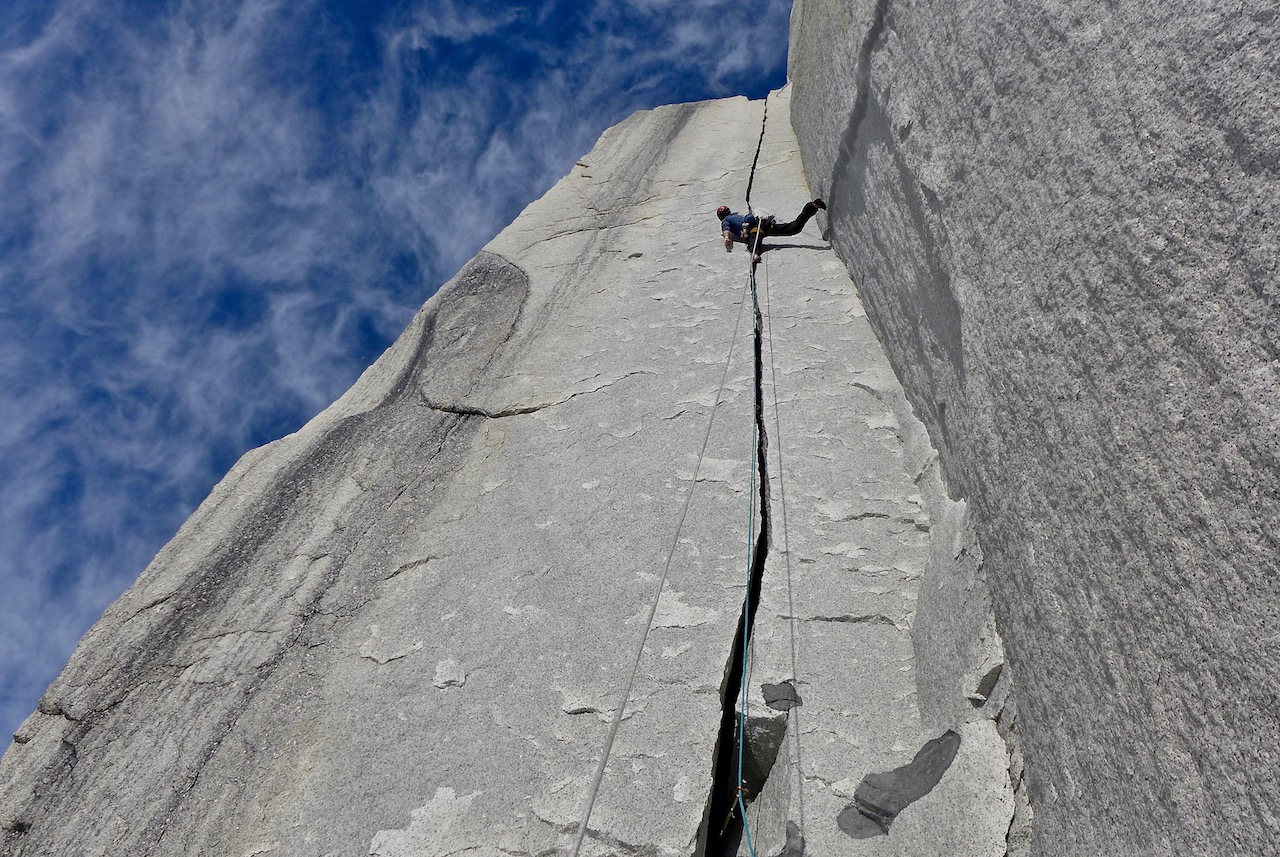
Because of a lot of snowy precipitation before the good weather we encountered more snow on the first pitches and ice in the cracks. Because we already knew the climbing, we still reached our high point relatively fast on our first day and climbed even one more pitch. Using same tactics with fixing ropes and returning to the comfortable bivy spot after pitch 9 as on the previous try.
Because of new snow and a lot of wet sections we didn’t focus on free climbing. Knowing that the crux of the route is still ahead of us, we decided to climb as efficient and safe as possible. But the route follows crack systems, most of which we believe would be free climbable in drier conditions. Also the overhanging part offered amazing passages which would probably go free at probably no harder than 8a. After we joined the Petit Prince route, there is a short overhanging A2 corner that we are not sure if it would go free, but we are also aware that once you start aiding, the perspective changes and it’s hard to switch back to the free climbing mindset. So maybe someone else will discover just that and remove the question mark from the free climbing vision.

We named our route Mir which means peace in Slovenian language. There are two main reasons for this name. Firstly because it didn't give us a peace of mind after the first attempt. We sensed that there might be a passage, but both agreed we weren't prepared to accept the risk of committing with the gear we had. Going up for the second attempt, we knew that nothing is guaranteed and we might end up going home without a single climb, but we both agreed that it offers us the right drive to give it our best as we knew we’ll enjoy the experience no matter the result.
Secondly we saw there were a lot of people trying the same routes or faces, which is not the experience we wanted to have, as being alone on a wild terrain is still the best and most pristine sensation that we seek in the mountains.

End of Silence
I am in the middle of a grey slab desperately looking for holds, already a couple of meters past the last bolt. I see a drilled 10mm hole that would perfectly fit the bolt that is not there… I fall and hit the wall 10m below quite hard. The climbing is not steep in this part, making falling really uncomfortable. After taking around 7 of these long falls, I am mentally wasted and need to rest. I rest at the belay for about an hour and try to get ready for a fight again. I make a plan in my head, pull myself back up and – in full-on screaming mode – I fight through the crux of this run out 7c+ pitch.
That’s how my first day on the route “End of Silence” went. I know most climbers who’ve repeated this climb first came from above to check the hard and run out pitches. It’s everyone’s personal decision on how to do it, but coming from above to check the route definitely takes away from routes like this. This was by far the hardest multi-pitch route I have ever tried and I wanted to test myself on if I’m ready for routes of such high difficulty.
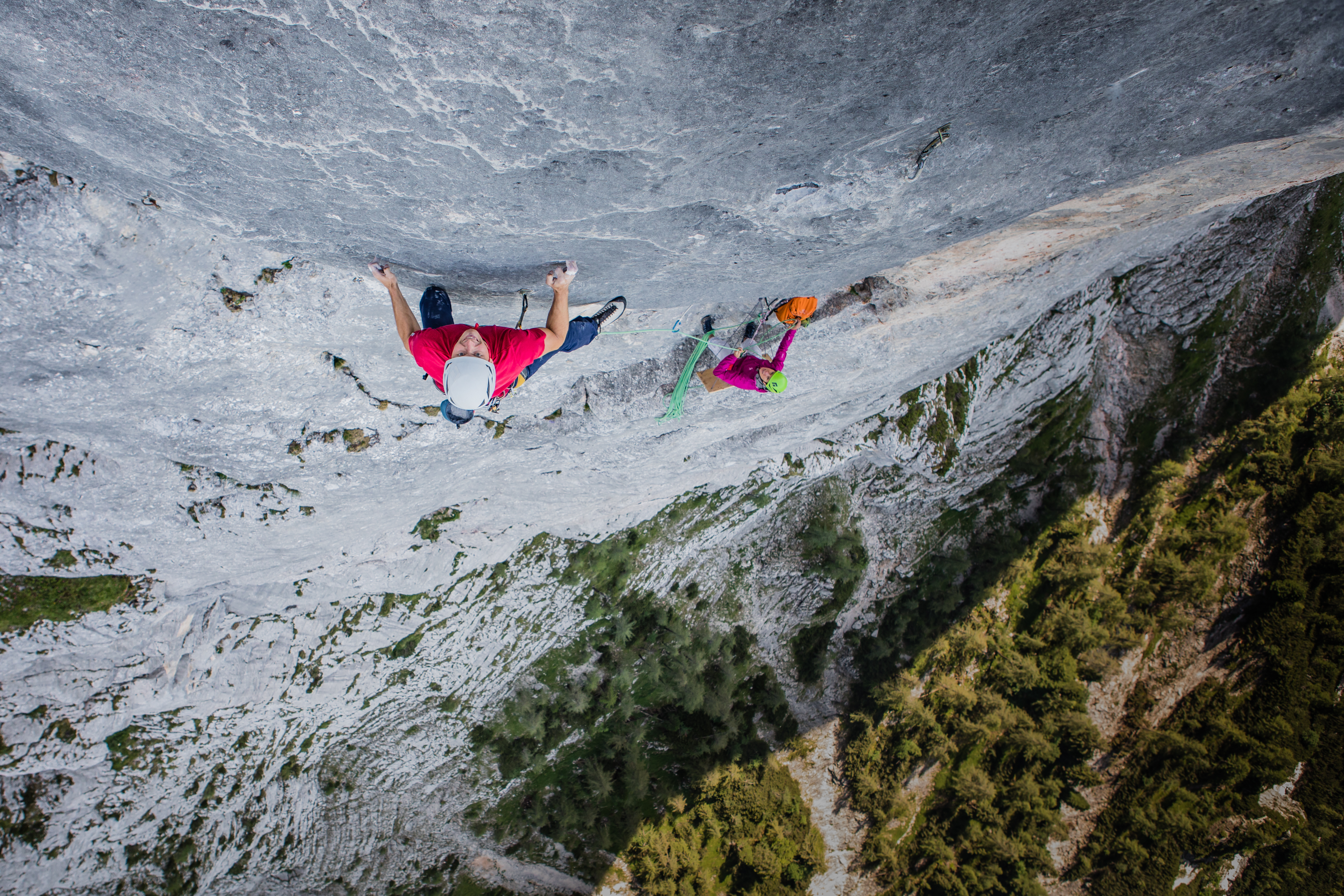
I felt I needed to climb everything from the ground up first to be satisfied with my performance. It took me two climbing days, with many memorable moments looking for holds high above the last bolt. While the first part of the project was finished, things were far from over. Climbing the whole route free in a day became my project for this summer.
I started working on the sequences alone using a fixed static rope. I climbed everything quite quickly, aside from the boulder crux in the most difficult pitch. Finger strength is normally not my weakness but after a winter of finger injury and lots of alpine climbing, my fingers simply weren’t used to the small pockets needed to hold on this crux. I was afraid I would injure myself trying this boulder too often so I decided to take a little break from the route and train on a “hangboard”. The weather was perfect for climbing during that time and I was struggling to not join everyone going out climbing on a perfect rock in the Berchtesgaden area. I knew climbing less and working on my weaknesses were keys to succeed, and it was very rewarding to see how quickly the focus and hard training payed off. I started to feel comfortable pulling on small pockets but the crazy summer heat wave hit the area right when I started to feel ready for another try.

I decided to try anyway and managed to climb everything up to the crux pitch. Once there, I failed three times. I still returned home happy though, seeing see I could climb that many hard pitches in one day. I just needed one more session in the crux pitch to fine tune the beta. On my next visit I found a better solution for the crux with a different footstep and was able to climb the pitch for the first time. After this, I knew I was able to do it –but I needed to keep a calm head and feel under pressure. It’s not easy in this kind of technical type of climbing, where the smallest mistake is enough to make you fall. But, at the same time, it’s what makes climbing in routes like this so special. Not only power will bring you success. You simply need to climb well and be precise.

I couldn’t imagine a better person to support me on a project like this than my girlfriend Ines. On Monday, July 22nd, we walked to the top of the wall with the idea to spend the night before starting my second try the next day. That same day I rappelled once more through the route to mark the holds and footholds with chalk. However, the marks got washed away by the rain and I knew how important they were for a successful free ascent. Ines prepared our camp and food before we enjoyed the sunset high above the valley floor together, but I need to admit I couldn’t fully enjoy it as I started to feel the pressure of the next day.
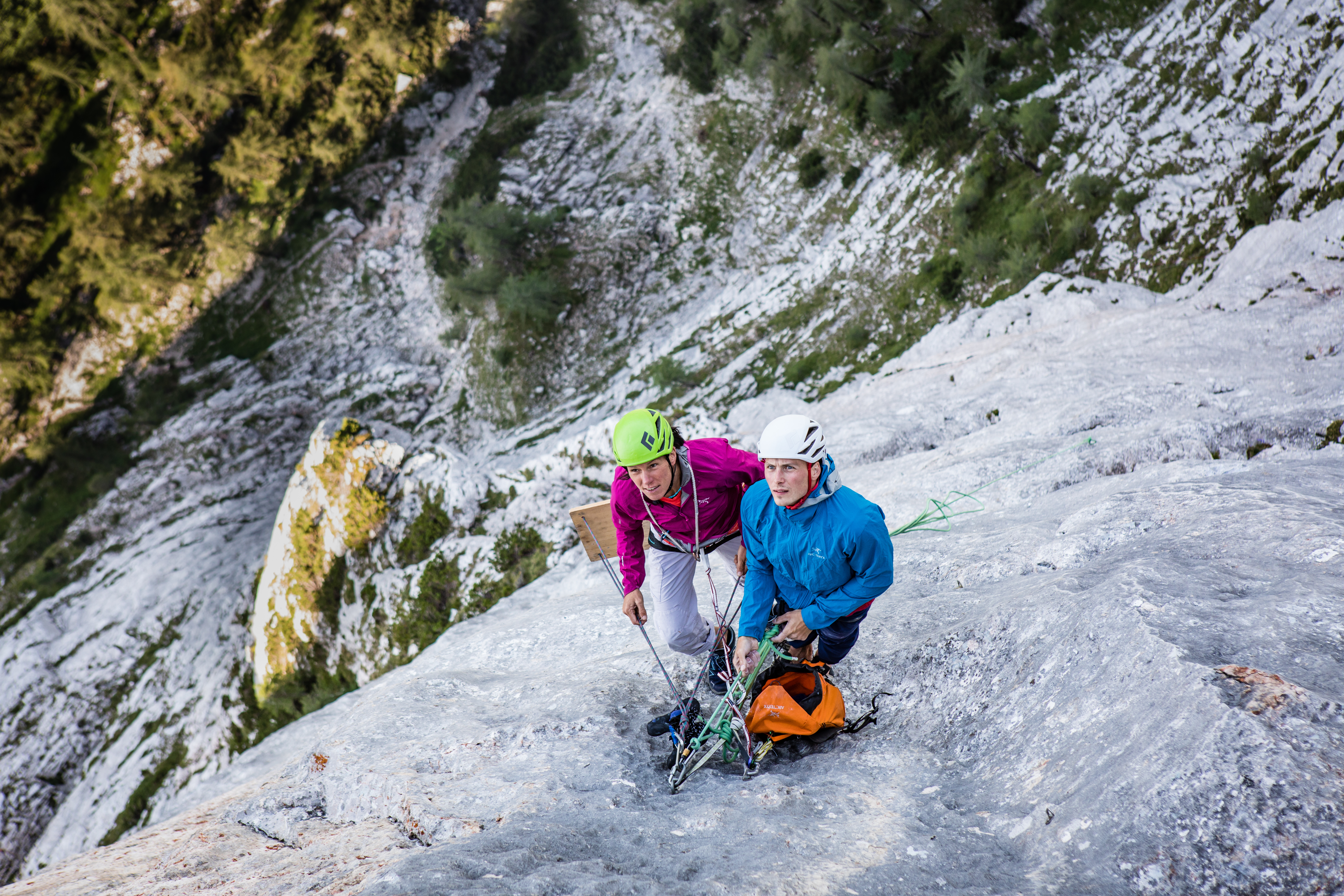
We descended to the base of the climb and I started the first pitch. After two meters, I had already taken a fall with a broken hold in my hand. I managed to recollect quickly and started the pitch from the beginning. I tried to focus only on the next few meters and not feel the weight of the crux pitches waiting high above. I climbed in control the entire way, even through the 7c+ and 8b pitches. At the belay below the 8b+ pitch I felt a bit nervous. But still feeling quite fresh, I was confident and managed to switch my mind into execution mode and pulled it off despite a small foot slip at the crux. Both of us started screaming like hell. Even though I still needed to climb a 7c and a 7a+ pitch, I knew nothing could take it away from me anymore. As I started to climb relaxed, I felt like I was flying between the holds in those last two pitches.
“End of Silence” was opened and free climbed by Thomas Huber. With its 11 pitches and difficulties up to 8b+ it is still among the most difficult alpine free climbs. This climb definitely opened my eyes to see what I am capable of in difficult rock routes. I’ve never climbed harder than 8b+ in a crag and never really focused on only rock climbing in my career. Because of this, I didn’t dare think I’d be able to climb a route like this. Encouraging words from Ines and new friends from the Berchtesgaden area made me decide to give it a try.

I often travel around the globe to climb in the big mountains and challenge myself – too often actually, in this time when everyone is keen on the environment and sustainability. Having a proper challenge only a 15 minute drive from home was really refreshing and made me think a lot about my career. I realized I don’t always need to travel thousands of kilometers to get what I’m looking for. It was a great experience to work on this route and I was once again surprised by the support and good energy the local climbers showed while I was trying.
At the moment, I’m a bit overwhelmed by the new possibilities when it comes to difficult rock climbing after this breakthrough. The send of “End of Silence” is definitely a nice reward after the hard work. But, knowing that I am improving every year in all aspects of climbing and mountaineering is an even more satisfying.

Facts:
Mountain: Reiteralm, Feuerhörndl
Route: End of Silence
Grade: 8b+ (7a+, 6c, 6a, 6a+, 7b+, 7c+, 7b, 8b, 8b+, 7c, 7a+) Length: 350m
First ascent and RP: Thomas Huber
I needed two days to climb the route, ground up, joined by Luka Krajnc on Day 1 and Ines Papert on Day 2. After another 7 days of working on the route and marking the holds, I redpointed the route on July 23rd belayed by Ines Papert.
The Sound Of Silence (M8, WI5)
Over a two day push on April 2 – 3, 2019 the team of Ines Papert, Luka Lindic and Brette Harrington completed the first route to climb the entire East Face of Mt. Fay (3234m) in the Alberta Rockies. As the group of climbers enjoy a day of rest in Canmore, Alberta, they share their thoughts on freeing the 1100m route.
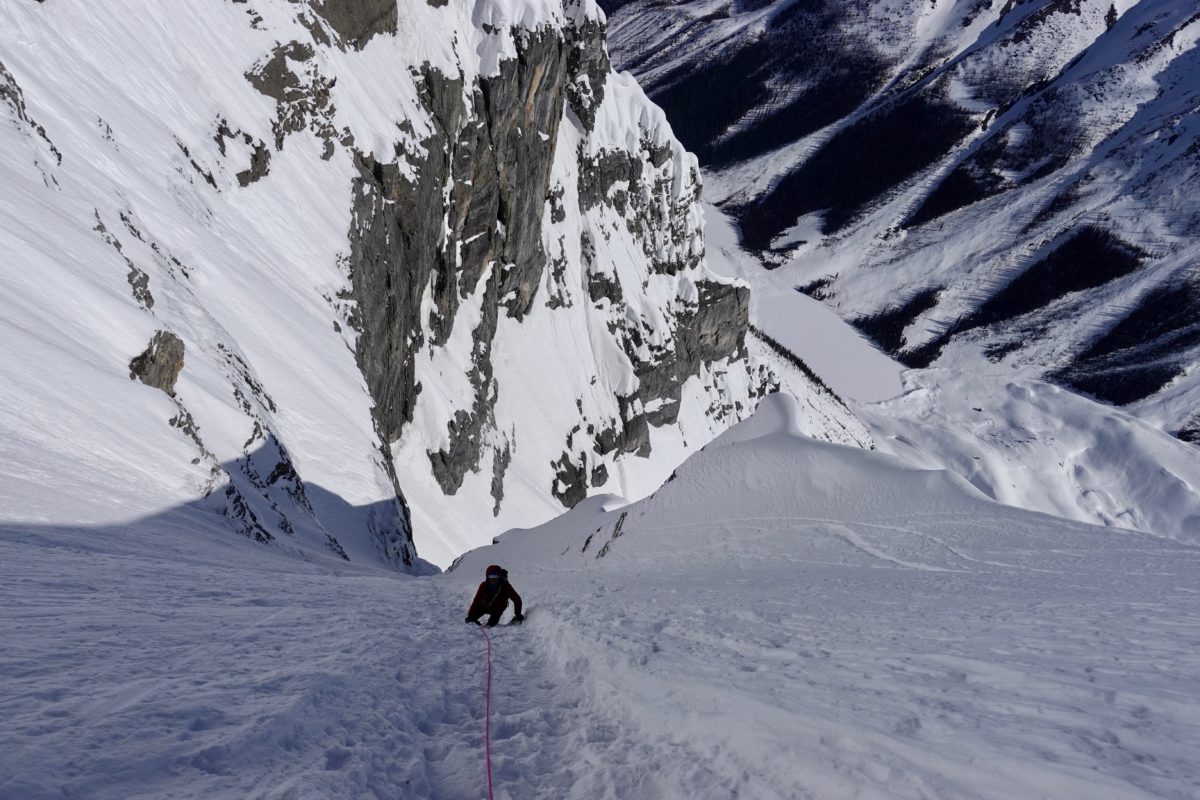
First repetition and new variation of "Selvaggia sorte" on Cima Tosa
First repetition and new variation of "Selvaggia sorte" on the 600m west face of Cima Tosa 3133m in the Brenta by Ines Papert and Luka Lindič on 1st January 2019.
After some wonderful Christmas holidays with family and friends back home in Berchtesgaden, we spontaneously decided to explore the Brenta group in the western Dolomites. As usual with a few calories too much and clearly too little movement through the holidays grew the desire for long days in the mountains. The conditions were promising and the weather was supposed to be windy but stable. We could imagine skipping the New Year party and instead climbing in the Alps. For both of us a climbing trip to the Brenta was a premiere and the long ascent during the dark morning hours in unknown terrain was not an option. On 30th December in the afternoon we shouldered our backpacks with tent, equipment and food for 2 days. The short days made an early stop necessary. Quickly our little tent was set up and the anticipation to try something unknown was huge.

The next morning we quickly noticed, that the route Filo d´Ambience (first climbed on December 15th, 2018) was in worst conditions than expected, since most of the ice was delaminated already. Wind and cold had changed everything a lot.
Now it was almost too late for a big wall on the last day of the year. We quickly made the decision to explore the surrounding walls and to create a good plan for the New Year's Day. We were intrigued by the spectacular valley surrounded with peaks and walls. We could see the thin ice lines everywhere but were in doubt which one would offer the best conditions.
And there it was, the most obvious line leading almost to the summit of the Cima Tosa with 3133 m, the second highest peak of the Brenta. Ice glued like plastic to the dolomite rock. All we knew was that we were climbing the west face of the Cima Tosa, but abandoned gear in the route soon led us to believe it was an existing route.

We took the direct line up ice that formed this year and the signs of other climbers disappeared. Thin, difficult to protect ice, was just good enough to enable us to always follow a direct line up the steep face. Each pitch held a surprise and offered more challenging climbing than expected. Soon the steep wall turned into a gully that we followed to the end. A few hundred meters higher we reached the summit of Cima Tosa at 16 o'clock and had just enough light to find the descent (3x rappelling) on the south side. At about 7.30 pm we reached our little tent, packed up quickly and ran back down to the valley for a pizza. Luka commented: "In Slovenia, we have a saying: What you do on the first day of the year, you will do all year." Well, we certainly won't be climbing a big mountain face every day in 2019 but definitely look forward to the trip to the Canadian Rocky Mountains in the spring.

Route details: Variation of "Selvaggia sorte“, Cima Tosa west face 600m, M6, WI 6+, possibly first ascent
Note: Selvaggia sorte M5 +, WI 5+ was opened in March 2013 by alpinists Tomas Franchini and Alessandro Lucchi and never repeated, according to Franchini. The team climbed the route until the end of the difficulties but had to skip the climb to the summit due to the onset of darkness and fog. When abseiling they run into the problems with rope, hence the route name (wild / bad luck).
